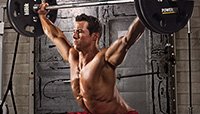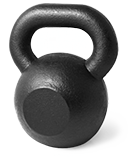Follow Us
Those large cannon balls with handles, sitting in the corner collecting dust, look intriguing. Something that heavy and evil-looking must be good for something, you think. But you're not about to start at the bottom, in the "pump" class with puny yellow and pink kettlebells that look like they belong in the daycare. And you're not about to give up your traditional strength training exercises for something that might be nothing more than hype.
I get it. I like lifting heavy weights too, especially over my head or on my back. And as much as I love basic kettlebell moves like the swing, get-up, and snatch, I also recognize that not everyone is ready to subject themselves to the learning curve that goes along with those movements. Luckily, there's a lot you can do with a heavy kettlebell, and it doesn't have to be complicated to be effective.
These five moves will get you strong without making you look stupid, and help you reap some of the benefits of kettlebell training, like improved core strength, mobility, stamina, and "in-between" strength. By that, I mean that strength in awkward positions that fighters and other athletes seem to have in spades, but that barbells, dumbbells, and machines seldom produce.
Farmer's Carry
The task is simple: You're simply going to carry a pair of kettlebells for either distance or time. Leave your lifting straps in your gym bag, but yes, you may use chalk.
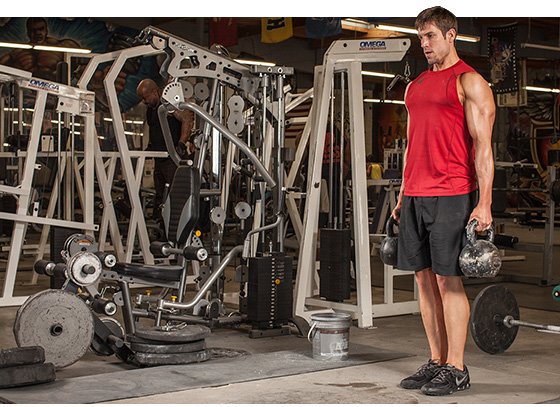
The benefits of the farmer's carry are many:
- Improved grip strength, obviously, but what often gets overlooked is how much that carries over to improved total body strength; stronger grip equals stronger
- A stronger core, which also translates to more overall strength
- Bigger traps from the strain of supporting the kettlebells
- The steely forearms like a farm laborer, from the increased tension required from holding the kettlebells
- Improved conditioning, because carrying a load while walking is incredibly energetically demanding
The farmer's carry can be summed up as simply "pick up and go," but a little cuing can help you reap the most benefits from the movement—and keep from injuring yourself while bending over to pick up the weights. That, not a crushed toe, is the biggest risk that accompanies the movement.
How To Perform The Farmer's Carry:
- Stand between a pair of kettlebells as if they were suitcases. If your gym has matching pairs, that's great. If not, then that's also great, because the unbalanced loading is even harder on your core.
- Take a deep breath—about 75-80 percent of maximum—and bend down, folding at the hips, to pick up the kettlebells; exhaling as you do so, similar to a deadlift. No bending the lower back!
- Tighten your abs, lock your ribcage to your pelvis, and keep it there for the duration of your walk. If you're using two kettlebells of different weights, this will be especially difficult.
- Walk either for distance or time; 20-30 yards or 30 seconds is a good start.
Spend about 10 minutes doing farmer's carries, at a point in your workout where it won't matter if your grip is fried afterward—like the end. Work up to heavier kettlebells if your gym has them, or longer distances if not.
Suitcase Carry
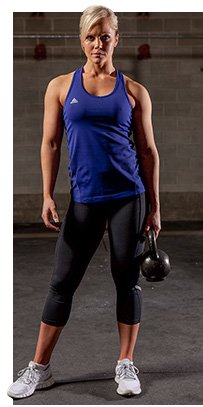
Think of the suitcase carry as half of a farmer's carry—you only load one side at a time. Why would you want to do that? It pounds the ever-living snot out of your midsection, making your core truly "functionally" strong. How? When you hold a kettlebell in one hand, your body has to contract all the muscles on the opposite side of your body—your obliques especially—to keep you from falling over sideways.
The suitcase setup and execution is exactly the same as the farmer's carry, with the obvious exception of having that extra kettlebell for balance. This means you need to be careful not to lean into the carry—that is, to bend toward the side without the kettlebell. Your torso should remain upright and perpendicular to the ground at all times. This is harder to pull off than you might think; you may feel like you're more or less straight, but a mirror will usually tell a different story.
Programming is the same, except you carry the kettlebell down your track in one hand, and carry it back in the other.
Rack Hold
The "rack" is where the kettlebells are received and held across the chest. It's where a clean finishes, and the overhead lifts start and finish. It's also a powerful position for building strength throughout the body, but especially in the midsection.
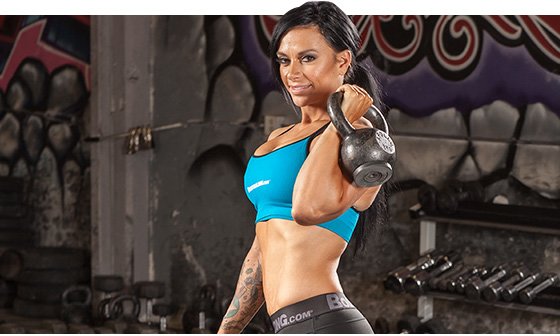
I'll be frank: For most people, the rack with two kettlebells is uncomfortable. With heavy kettlebells, it's very uncomfortable. So start with a single kettlebell until you get the hang of the position, but once you do, start using a pair of kettlebells. By teaching you to get comfortable with discomfort, the timed rack helps you master the type of full-body tension that carries over to pretty much every other type of kettlebell and barbell lift.
How To Perform The Rack Hold:
- Stand with a single kettlebell between your feet, the handle "up" like the grip on a pistol as opposed to facing you, like the grip on a barbell.
- Bend down as if you were about to deadlift the kettlebell and grab the handle with your working hand. Cover that hand with your other hand, in a "pistol grip."
- Deadlift the kettlebell, and as you approach lockout, use momentum to "cheat curl" the kettlebell into the rack.
- The kettlebell will be resting on two points of contact: The back of your wrist and on your upper arm, just below your shoulder. Your forearm and upper arm will form a triangle in which the kettlebell sits.
- Your hand should be facing the center of your body, and your elbow pointed down toward your hip.
- Hold this position for 30-60 seconds. Perform as many sets as you like. Like the farmer's carry, 10 minutes at the end of your workout is a good plan.
Rack Walk
This beauty is a combination of a loaded carry and the rack hold. It adds a level of difficulty to the carry that many people find surprising, in the form of increased abdominal stress, respiration demand, and the way it reaches the little stabilizer muscles along your spine.
To perform the rack walk, simply cheat curl the weight up to the clean position as you did with the rack hold, and then take off. Perform it with the same parameters as the other carries.
Front Squat
Many gym rats and bodybuilders don't have the necessary wrist and shoulder flexibility to perform a true barbell front squat with a clean grip. As a result, they're forced to use the awkward "bodybuilder" grip, which promotes rounding of the upper back, and which in turn can injure the lower back. This makes the kettlebell the perfect tool for front squats.
Holding one or two kettlebells also puts a larger-than-normal pressure on the abs, making them work harder than a far greater barbell load would, as I mentioned in my last article. Additionally, I consider the kettlebell front squat to be an incredibly effective "loaded mobility" exercise. Because of the way the load is situated, your abs automatically contract, your shoulders depress, and your hips magically seem to have more space in them, allowing for a deeper squat than many people can manage with just a barbell.
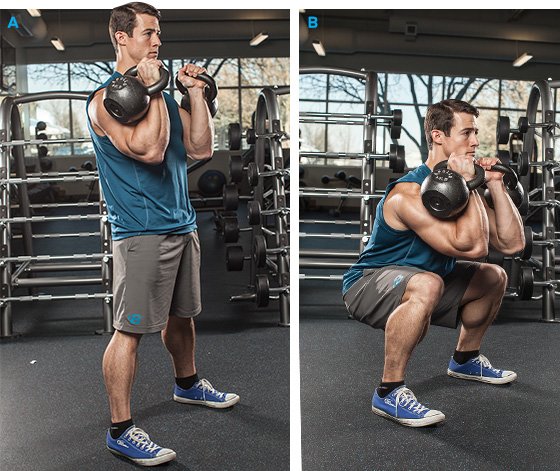
Kettlebell Front Squat
Training with a single kettlebell front squat exposes the weaknesses in your midsection while simultaneously strengthening it. It also serves as a little assessment, since if the two sides feel dramatically different, there's a good chance you have a side-to-side imbalance. If that's the case, you may not want to load with a heavy barbell, due to the possibility of injury, until you spend some good time with the kettlebell alternative.
How To Perform The Kettlebell Front Squat:
- Follow the setup for the rack hold.
- Take a deep breath, about 75-80 percent of maximum, and hold it.
- Squat until you go as low as you can, maintaining pressure in your abs, and keeping a slight extension in your lower back.
- Pause for a second and stand up, exhaling through pursed lips and matching the exhalation to the ascent.
- Perform sets of 5 reps.
Single-Arm Floor Press

Has your bench press stalled? This little beauty may be just what the doctor ordered. The single-arm floor press will not only strengthen your triceps and your lockout, but it will help you refine your bench press groove by positioning your arm in the strongest position to lift big weights.
How To Perform The Single-Arm Floor Press:
- Lie on your back with the kettlebell next to your right hip.
- Roll to your side, and grab the kettlebell by the handle, using the pistol grip, like you did with the rack hold.
- Roll the kettlebell onto your stomach with two hands.
- Press it up with both hands so the kettlebell is over your sternum.
- Remove your left hand and lower the kettlebell so your forearm is perpendicular to the floor and your triceps rest on the floor. Your upper arm should be approximately 45 degrees from your body.
- Pause with your upper arm on the floor for 2-3 seconds and then press the kettlebell. *Perform 5-10 reps, and then put both hands on the kettlebell, lower it to your stomach, then roll back to your side and put the kettlebell on the floor.
Go Heavy!
These six movements are more than enough to teach you about the unique challenges and benefits of working with kettlebells. Experienced kettlebell lifters regularly utilize things like loaded carries and floor presses to address strength deficiencies and practice building tension.
When you're ready, the floor press also has the benefit of preparing your arms and shoulders for one of the best kettlebell exercises you can do: the Turkish get-up. Until then, just keep picking up those heavy beasts, squeezing your core for all it's worth, and holding on for dear life.
Recommended For You
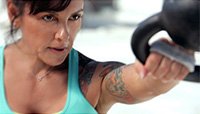
Swing For The Fences: Kettlebell Training - Burn Fat And Build Muscles!
Make the kettlebell swing your 1-stop shop for increased muscle size, definition, fat loss, and the heart of a racehorse!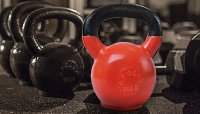
Kettlebell Explosion: Harness The Power Of The Kettlebell Swing
Don't try to learn the kettlebell swing by watching it get butchered in your local gym. Use these drills to nail this powerful movement once and for all!